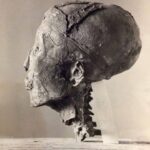
When King Tutankhamun’s mummy was first examined, it was discovered that the body could not be easily separated from the coffin, as the resins and unguents used in the embalming process had seeped into the wrappings, effectively adhering the body to the coffin. In order to remove the body, it had to be carefully chiseled out.
This process was painstaking and involved cutting the torso in half at the level of the hips to extract the pelvis and legs. The arms were disarticulated at the shoulders, elbows, and wrists to allow further access and the removal of jewelry, including bracelets. Each body part was then treated with hot paraffin wax to stabilize the remains.
To continue the unwrapping process and ensure proper preservation, the hands and feet were reattached using resin. Afterward, hot knives were employed to detach the head and neck from the famous gold mask that had adorned the young king’s face. In order to assess the condition of the teeth, a surgical incision was made around the inner jaw and across the throat. This damage was later repaired with resin to ensure the body’s preservation, a crucial part of the mummification process.
This meticulous disarticulation of King Tut’s remains provided anatomists with clear views of the bones, allowing them to accurately estimate the king’s age at the time of his death. The detailed work done on his body has contributed significantly to our understanding of ancient Egyptian burial practices and the physical condition of one of history’s most famous pharaohs.
Despite the complex procedures involved, the preservation and restoration efforts ultimately allowed for a comprehensive analysis of the mummy, shedding light on the young king’s life and health.










Leave a Reply